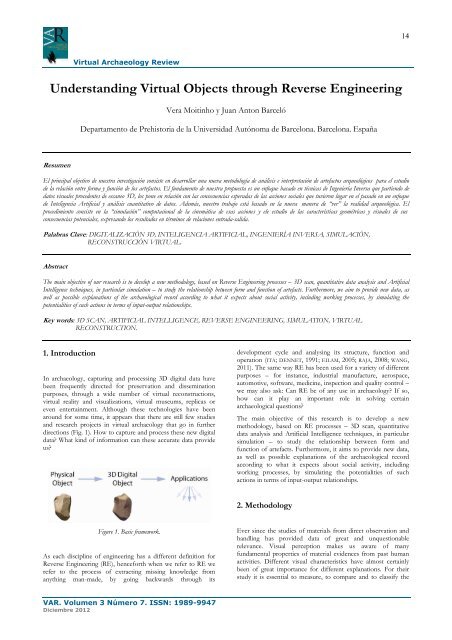Virtual Museums
Virtual Museums
Virtual Museums
You also want an ePaper? Increase the reach of your titles
YUMPU automatically turns print PDFs into web optimized ePapers that Google loves.
<strong>Virtual</strong> Archaeology Review<br />
Understanding <strong>Virtual</strong> Objects through Reverse Engineering<br />
Resumen<br />
VAR. Volumen 3 Número 7. ISSN: 1989-9947<br />
Diciembre 2012<br />
Vera Moitinho y Juan Anton Barceló<br />
Departamento de Prehistoria de la Universidad Autónoma de Barcelona. Barcelona. España<br />
El principal objetivo de nuestra investigación consiste en desarrollar una nueva metodología de análisis e interpretación de artefactos arqueológicos para el estudio<br />
de la relación entre forma y función de los artefactos. El fundamento de nuestra propuesta es un enfoque basado en técnicas de Ingeniería Inversa que partiendo de<br />
datos visuales procedentes de escaneo 3D, los pone en relación con las consecuencias esperadas de las acciones sociales que tuvieron lugar en el pasado en un enfoque<br />
de Inteligencia Artificial y análisis cuantitativo de datos. Además, nuestro trabajo está basado en la nueva manera de “ver” la realidad arqueológica. El<br />
procedimiento consiste en la “simulación” computacional de la cinemática de esas acciones y ele estudio de las características geométricas y visuales de sus<br />
consecuencias potenciales, expresando los resultados en términos de relaciones entrada-salida.<br />
Palabras Clave: DIGITALIZACIÓN 3D, INTELIGENCIA ARTIFICIAL, INGENIERÍA INVERSA, SIMULACIÓN,<br />
RECONSTRUCCIÓN VIRTUAL.<br />
Abstract<br />
The main objective of our research is to develop a new methodology, based on Reverse Engineering processes – 3D scan, quantitative data analysis and Artificial<br />
Intelligence techniques, in particular simulation – to study the relationship between form and function of artefacts. Furthermore, we aim to provide new data, as<br />
well as possible explanations of the archaeological record according to what it expects about social activity, including working processes, by simulating the<br />
potentialities of such actions in terms of input-output relationships.<br />
Key words: 3D SCAN, ARTIFICIAL INTELLIGENCE, REVERSE ENGINEERING, SIMULATION, VIRTUAL<br />
RECONSTRUCTION.<br />
1. Introduction<br />
In archaeology, capturing and processing 3D digital data have<br />
been frequently directed for preservation and dissemination<br />
purposes, through a wide number of virtual reconstructions,<br />
virtual reality and visualizations, virtual museums, replicas or<br />
even entertainment. Although these technologies have been<br />
around for some time, it appears that there are still few studies<br />
and research projects in virtual archaeology that go in further<br />
directions (Fig. 1). How to capture and process these new digital<br />
data? What kind of information can these accurate data provide<br />
us?<br />
Figure 1. Basic framework.<br />
As each discipline of engineering has a different definition for<br />
Reverse Engineering (RE), henceforth when we refer to RE we<br />
refer to the process of extracting missing knowledge from<br />
anything man-made, by going backwards through its<br />
development cycle and analysing its structure, function and<br />
operation (ITA; DENNET, 1991; EILAM, 2005; RAJA, 2008; WANG,<br />
2011). The same way RE has been used for a variety of different<br />
purposes – for instance, industrial manufacture, aerospace,<br />
automotive, software, medicine, inspection and quality control –<br />
we may also ask: Can RE be of any use in archaeology? If so,<br />
how can it play an important role in solving certain<br />
archaeological questions?<br />
The main objective of this research is to develop a new<br />
methodology, based on RE processes – 3D scan, quantitative<br />
data analysis and Artificial Intelligence techniques, in particular<br />
simulation – to study the relationship between form and<br />
function of artefacts. Furthermore, it aims to provide new data,<br />
as well as possible explanations of the archaeological record<br />
according to what it expects about social activity, including<br />
working processes, by simulating the potentialities of such<br />
actions in terms of input-output relationships.<br />
2. Methodology<br />
Ever since the studies of materials from direct observation and<br />
handling has provided data of great and unquestionable<br />
relevance. Visual perception makes us aware of many<br />
fundamental properties of material evidences from past human<br />
activities. Different visual characteristics have almost certainly<br />
been of great importance for different explanations. For their<br />
study it is essential to measure, to compare and to classify the<br />
14


